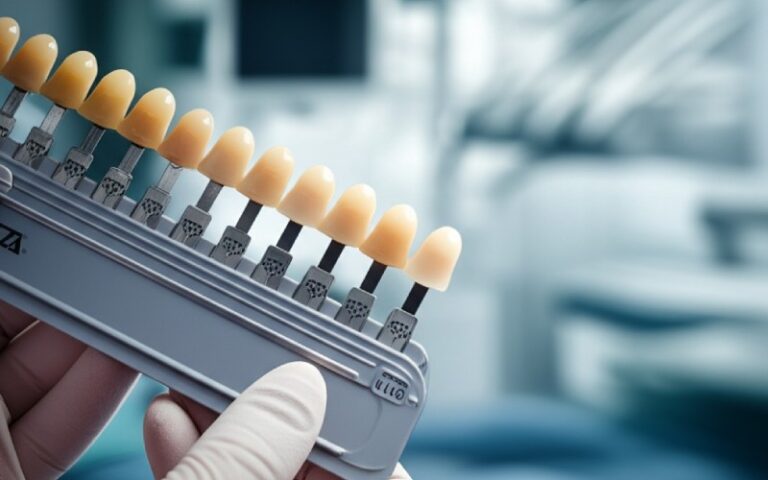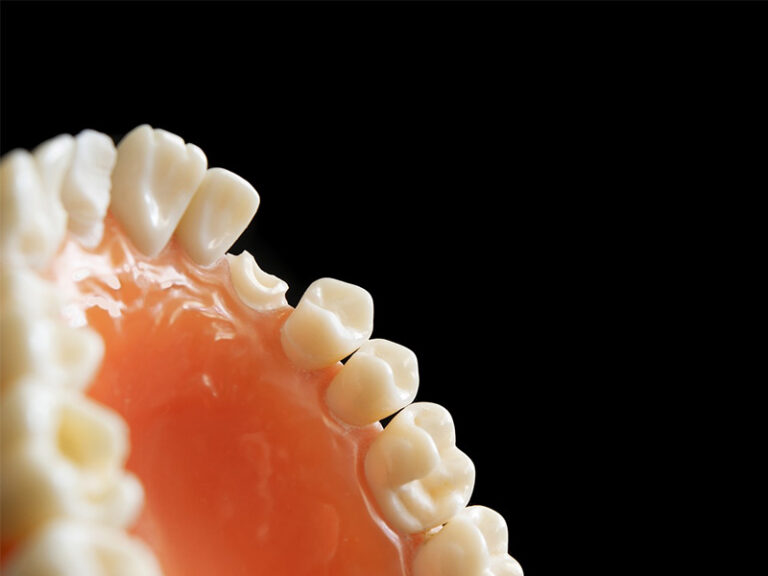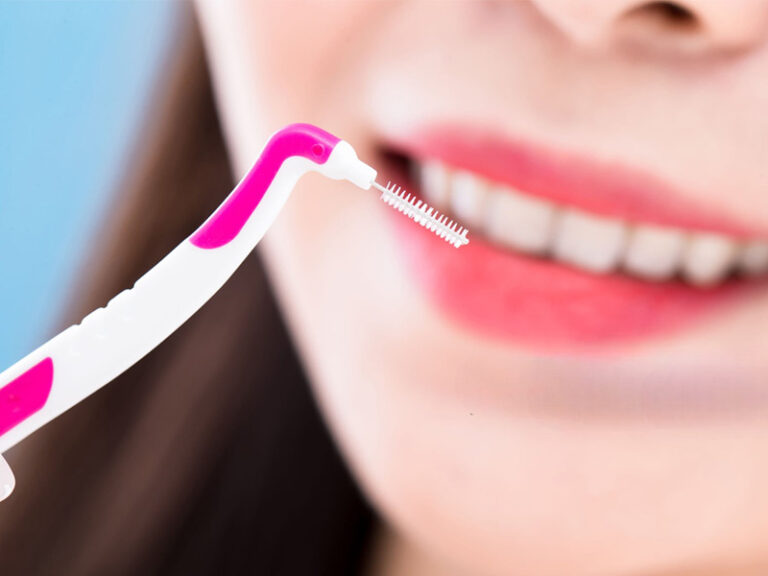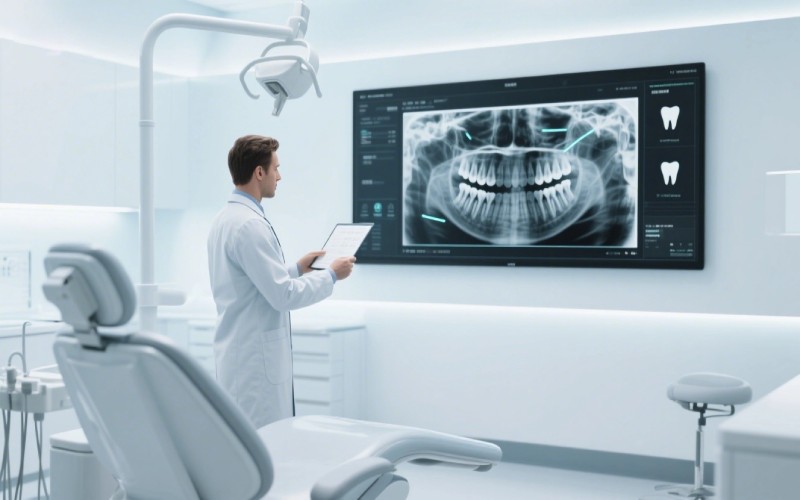
How AI in Dentistry May Change Your Next Dental Visit
The reality of AI in dentistry is much more practical and, frankly, quite exciting. It’s not about replacing the human touch of a skilled dentist but about giving them powerful new tools to improve patient care. From spotting tiny cavities that the human eye might miss to creating super-precise treatment plans, AI is quietly revolutionizing the dental world. This article will explore the many ways AI is being used in dentistry today and what we can expect in the future. I’ll share how these advancements can lead to better oral health for all of us.
Table of Contents
What is AI in Dentistry, and Why Should You Care?
You might be wondering, what exactly is “AI in dentistry”? At its core, it’s about using smart computer systems to help dental professionals do their jobs even better. Think of it as a highly intelligent assistant for your dentist. This isn’t science fiction; it’s happening right now. These AI systems, which are a form of artificial intelligence, use something called machine learning. This means they can learn from vast amounts of data, like thousands of dental X-rays, to spot patterns that might be invisible to the human eye. For you, the patient, this means the potential for earlier and more accurate diagnoses, which can lead to simpler and more effective treatments. The application of AI in dentistry is a big step forward in oral health.
The use of AI in dentistry is not about taking the “human” out of healthcare. Instead, the goal of these intelligence technologies is to enhance the skills of your dentist. By using artificial intelligence, your dental team can provide a higher level of patient care. The AI can handle some of the time-consuming tasks, like analyzing dental images or managing appointment scheduling, freeing up the dentist and their staff to focus more on you. This seamless integration of AI into the dental workflow can lead to better patient outcomes and a more efficient dental practice. Ultimately, the use of AI has the potential to make your dental care more personalized and proactive.
How Does AI Help Dentists with Image Analysis?
One of the most powerful applications of AI in dentistry is in image analysis. Dentists rely heavily on images like X-rays, also known as radiographs, to see what’s happening inside your teeth and jaws. However, interpreting these images can sometimes be tricky. An AI algorithm can be trained on millions of dental images, learning to recognize the subtle signs of problems like dental caries (cavities) or bone loss around the teeth. When your dentist takes a radiograph, an AI system can analyze it in seconds and highlight areas of concern that the dentist can then examine more closely. This doesn’t replace the dentist’s expertise; it acts as a second pair of eyes, helping to ensure that nothing is missed.
This kind of advanced image analysis is a game-changer for early detection. The sooner a problem is found, the easier and less invasive the treatment is likely to be. For example, an AI might detect a tiny cavity that is just starting to form, allowing your dentist to address it before it becomes a bigger issue requiring a more complex procedure. The use of AI in analyzing radiographic images means that your dental team can be more confident in their diagnoses. This technology, sometimes referred to as digital dentistry, is helping to make dental care more precise and effective.
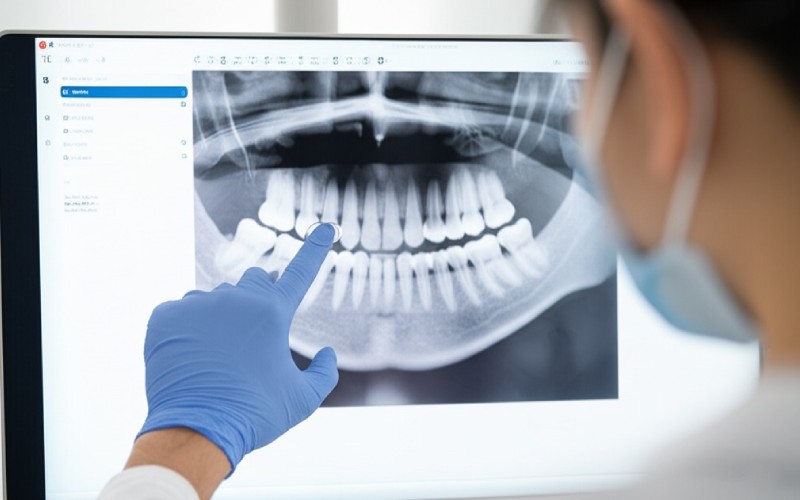
Can AI Really Improve Dental Diagnosis?
The short answer is yes. The integration of AI in dentistry has been shown to significantly improve diagnostic accuracy. Think about it from the dentist’s perspective. They see hundreds, if not thousands, of dental images over their career. An AI system, on the other hand, can be trained on a dataset of millions of images from all over the world. This gives the AI an incredibly broad base of knowledge to draw from. When an AI algorithm analyzes a patient’s radiograph, it compares it to this vast library of images to identify potential issues with a high degree of accuracy.
This doesn’t mean the AI makes the final diagnosis. The dentist is still the expert who considers all aspects of a patient’s oral health. The AI system provides valuable data and insights that help the dentist make a more informed decision. For instance, research has shown that AI can help dentists detect more cavities and reduce the number of missed diagnoses. This improved accuracy in diagnosis is a cornerstone of the benefits of AI in dentistry. It leads to better treatment planning and ultimately, better patient outcomes.
What Role Does AI Play in Treatment Planning?
Once a diagnosis is made, the next step is creating a treatment plan. This is another area where AI is making a significant impact. An AI system can analyze a patient’s specific data, including their dental images, medical history, and even genetic factors, to suggest the most effective treatment options. For example, if you need a dental implant, an AI algorithm can analyze your bone density and other factors to predict the likelihood of success for different types of implants. This allows your dentist to create a truly personalized treatment plan tailored to your individual needs.
The use of AI in treatment planning isn’t just about suggesting procedures. It can also help visualize the expected outcome. For orthodontic treatments like braces or clear aligners, AI can create a 3D simulation of how your teeth will move over time, giving you a clear picture of what to expect. This ability to predict and visualize outcomes helps both the dentist and the patient make confident decisions about the best course of action. This application of AI is a powerful tool for ensuring that your dental treatment is as effective and predictable as possible.
How is AI Used to Detect Periodontal Disease?
Periodontal disease, or gum disease, is a common condition that can lead to tooth loss if not treated early. Detecting it in its initial stages is crucial. Here’s where AI can be a big help. AI algorithms can analyze dental radiographs to measure bone levels around the teeth. Bone loss is a key indicator of periodontal disease. By detecting even small amounts of bone loss, an AI system can alert the dentist to the presence of the disease sooner than might be possible with a visual examination alone.
Early detection of periodontal disease allows for more conservative and effective treatment. Instead of needing surgery, you might only need a deep cleaning and improved at-home oral hygiene. Some dental AI software, like Pearl AI, is specifically designed to identify signs of periodontal disease on X-rays. This use of AI helps dental professionals be more proactive in managing their patients’ oral health and preventing serious problems down the line.
Can AI Help Prevent Oral Cancer?
The early detection of oral cancer is critical for successful treatment. While your dentist always performs a visual screening for oral cancer during your check-up, AI can provide an extra layer of protection. AI systems can be trained to recognize the early signs of oral cancer in dental images and even in photographs of the inside of your mouth. If the AI detects a suspicious-looking area, it will flag it for the dentist to investigate further.
This application of AI in dentistry is still evolving, but it holds tremendous promise. By using AI to analyze images for potential signs of oral cancer, dentists may be able to identify the disease at its earliest, most treatable stage. This could save lives. The ongoing AI research in this area is focused on improving the accuracy of these systems and making them a standard part of routine dental care. The potential for AI to aid in the early detection of oral cancer is one of the most exciting developments in the field.
How Does AI Streamline the Dental Practice Workflow?
Beyond clinical applications, AI is also being used to make the dental practice itself run more smoothly. Many of the administrative tasks in a dental office, such as appointment scheduling, patient communication, and billing, can be time-consuming. AI-powered software can automate many of these processes, reducing the administrative burden on the dental staff. For example, an AI chatbot on the dental practice’s website can answer common patient questions and even schedule appointments.
This automation frees up the front office team to focus on more complex tasks and provide better customer service to patients. A more efficient workflow means less waiting time for you and a more organized and pleasant experience overall. The integration of AI into the administrative side of a dental practice is a win-win: the practice runs more efficiently, and patients receive better service. This is a practical example of how AI can improve the entire patient journey.
What are the Benefits of Integrating AI into a Dental Practice?
The benefits of integrating AI into a dental practice are numerous and impact both the dental professionals and the patients. For dentists, AI provides a powerful tool to enhance their diagnostic and treatment planning capabilities. It can help them work more efficiently and with greater confidence. The use of AI can also lead to a reduction in human error. By automating routine tasks, AI allows the dental team to focus more on patient care and building relationships.
For patients, the benefits of AI are centered around improved oral health outcomes. Earlier detection of problems like cavities, periodontal disease, and even oral cancer can lead to less invasive and more successful treatments. AI can also lead to more personalized and predictable treatment plans. Ultimately, the integration of AI in dentistry is about providing a higher standard of care and empowering patients to take a more active role in their oral health.
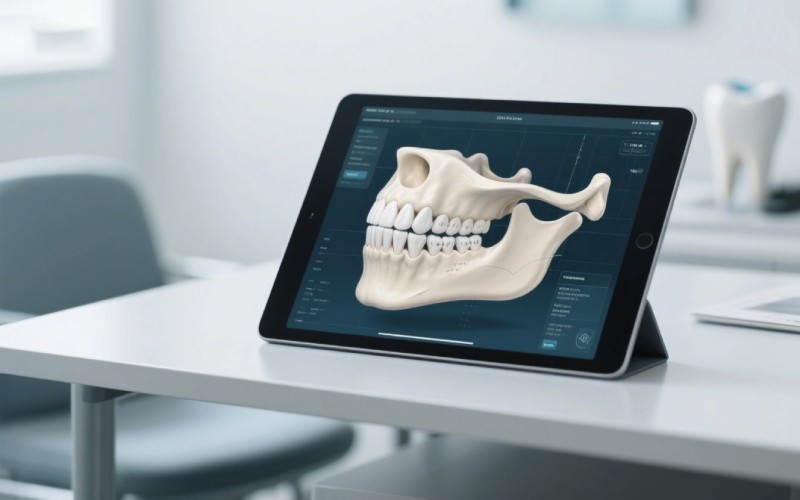
What Does the Future of AI in Dentistry Look Like?
The future of AI in dentistry is incredibly bright. We can expect to see even more sophisticated AI tools and applications in the coming years. AI research is constantly pushing the boundaries of what’s possible. One exciting area is predictive analytics. In the future, an AI system might be able to analyze your genetic information, lifestyle, and oral health history to predict your risk of developing certain dental conditions. This would allow your dentist to create a truly personalized preventive care plan to keep your mouth healthy.
We may also see more use of robotics in dentistry, guided by AI. Imagine a robot assisting a dentist with a complex procedure, ensuring incredible precision and a minimally invasive approach. Teledentistry, or remote dental care, will also likely become more common, with AI-powered platforms allowing you to have a virtual consultation with your dentist from the comfort of your own home. The future of dentistry is one where technology and human expertise work together to provide the best possible care.
How Will AI Applications Impact Patient Care?
Ultimately, the goal of all these AI applications is to improve patient care. By providing dentists with more accurate diagnostic tools, AI can help ensure that you receive the right treatment at the right time. More personalized treatment planning means that your dental care will be tailored to your specific needs, leading to better results. And a more efficient dental practice means a better overall experience for you as a patient. The use of AI has the potential to make dental care more accessible, affordable, and effective for everyone.
As a patient, you can look forward to a future where your dentist has even more advanced tools to help you maintain a healthy smile. The use of artificial intelligence in dentistry is not about replacing the trusted relationship you have with your dental professionals. It’s about enhancing that relationship by providing them with the best possible information and technology to care for your oral health. The future of dentistry is a partnership between human intelligence and artificial intelligence, working together for the benefit of the patient.
In Summary
Here are the most important things to remember about AI in dentistry:
- AI is a tool to help dentists. It enhances their skills and doesn’t replace them.
- AI improves diagnosis. It can spot problems like cavities and gum disease earlier and more accurately.
- AI helps with treatment planning. It allows for more personalized and predictable treatments.
- AI makes dental practices more efficient. It automates administrative tasks, leading to better patient service.
- The future of AI in dentistry is bright. We can expect even more advanced applications that will further improve patient care.


